Split
Split provides a framework for feature flag-driven development, testing, and experimentation. This workflow creates change records so you can monitor the impact of Split features when they're toggled on or off. You can then build automations to update stakeholders, or send messages based on feature flag changes.
How it works
When an alert is generated in Split, it sends a JSON-formatted webhook to xMatters, based on user-defined feature flags. A Split trigger in xMatters parses the webhook and creates a change record. The webhook includes essential data you can use to enrich notifications to users or when building automated tasks.
Install the workflow
The following instructions describe how to install the workflow through the xMatters one-click installation process.
- Go to the Workflow Templates page and click the Split tile.
- On the Set up the workflow tab, give the workflow a name that identifies its purpose (this must be unique in your instance), add an optional description, and set the default incident type (if applicable). Any built-in Initiate Incident steps in the workflow will automatically be set to the selected incident type.
- You can edit these later, if needed.
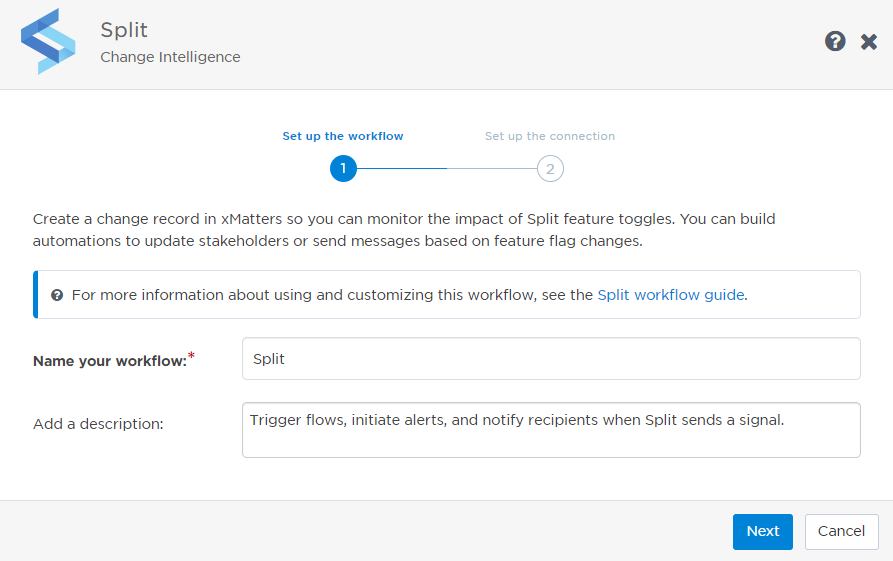
- You can edit these later, if needed.
- Click Next.
- Copy the Trigger URL. You'll use this URL when configuring Split.

- Send a test signal to the trigger URL to test the connection.
- Click Open Workflow to go to the workflow and customize it, or click Close to close the installation window.
Configure Split to send requests to the trigger URL
To have Split send alerts to the flow trigger, you need to configure a webhook and set it to use the trigger URL.
Create an integration between Split and xMatters.
- In Split click your profile icon, then select Admin settings.
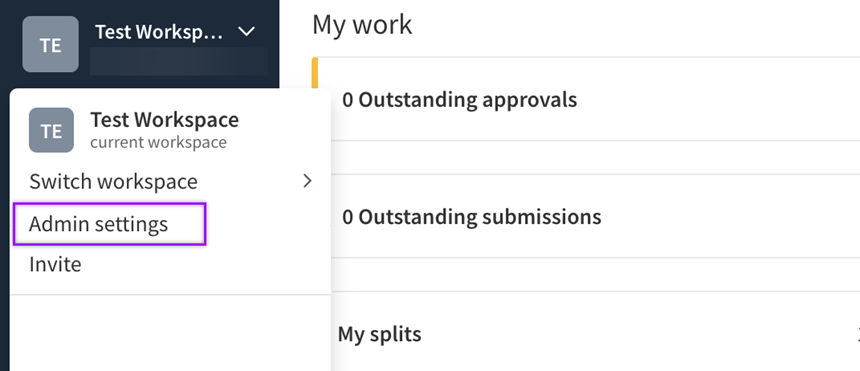
- In the Admin settings menu go down to Integration settings, and click Integrations.
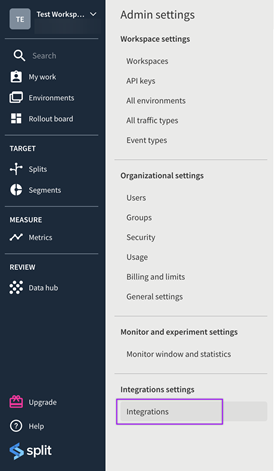
- Go to Outgoing Webhook (Audit Logs) from the list of available integrations and click Add.
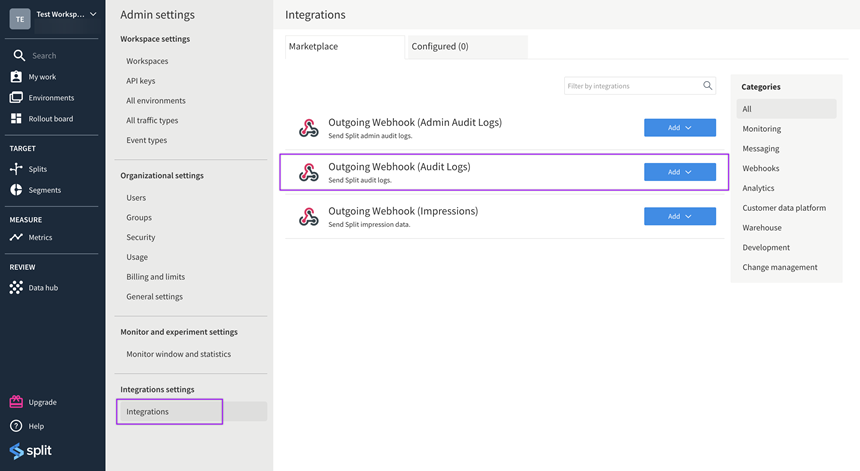
- Select the workspace for the integration from the Add drop-down menu.
- Specify the environment or environments you want the webhook to monitor in the Environments field.
- In the URL field, add the trigger URL you copied from Flow Designer.

- Add the target names of any recipients you want to notify when the alert fires.
- For URL authentication, use an ampersand to attach recipients. For example, if you want to notify Emma Pearson and the on-call members in the group responsible for the Antares service, you'd add &recipients=epearson,antares to the end of the URL.
- For other authentication types, use a question mark to attach recipients. For example, if you want to notify Barry Gull and the on-call members in the group responsible for the Cassiopeia service, you'd add ?recipients=bgull,cassiopeia to the end of the URL.
- You must URL-encode any special characters or spaces in the target names.
- Optional: Click Send Test Message to test the trigger URL and recipients.
- Click Save.
You're ready to use the webhook to trigger automated flows, including steps such as sending alerts and initiating incidents, though we always recommend testing before putting things into use.
To have Split send alerts to the flow trigger, you need to configure a webhook and set it to use the trigger URL.
Set recipients in the trigger URL
The trigger expects the recipients in the trigger URL. When you copy the URL from xMatters, it includes the recipients parameter: recipients=<yourname>. Of course, you don’t want to receive all the alerts.
To change the recipients for alerts from this webhook, swap out your name for the people or groups you want to target. The encoding used to add the recipient target names is based on the type of authentication you select in Flow Designer.
- For URL authentication, use an ampersand to attach recipients. For example, if you want to notify Emma Pearson and the on-call members in the group responsible for the Antares service, you'd add &recipients=epearson,antares to the URL.
- For other authentication types, use a question mark to attach recipients. For example, if you want to notify Barry Gull and the on-call members in the group responsible for the Cassiopeia service, you'd add ?recipients=bgull,cassiopeia to the URL.
Remember to URL-encode any special characters, including spaces, in your group names.
We recommend using groups so you can take advantage of the xMatters group features — rotations, escalations, and absences — to reach the right on-call people to jump on an issue.
Set the impacted or associated service
To set a recipient for this webhook, add the name of a single impacted or associated service to the end of the trigger URL. For example, to set the associated service as 'Antares Service', add &recipients=Antares%20Service to the trigger URL. Remember to URL-encode any special characters, including spaces, in your service name.
After setting the recipient on the Split webhook, go to Flow Designer and open the Change Record step. Drag and drop the Recipients variable into the Associated Service field. When changes are received, the associated or impacted service is notified of the change.
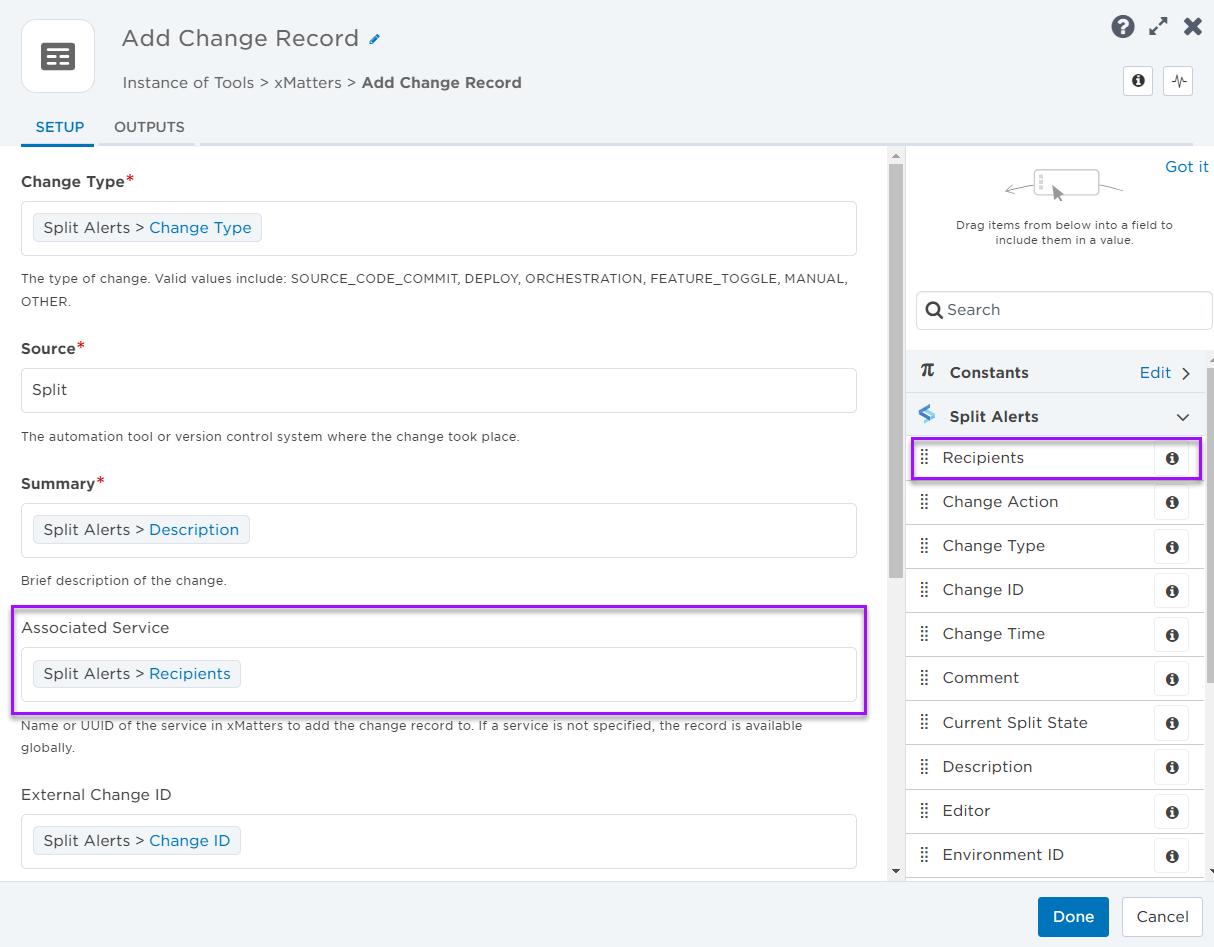
You can also manually add a service by typing its name into the Associated Service field.

Next Steps
Now that you've installed the workflow, you can use it as-is, or customize it to suit your needs better. Here are some examples of things you can add to the workflow to customize it:
- Use Slack or Microsoft Teams steps to add feature flag changes to a chat channel.
- Use a Create Alert step to notify stakeholders about the change.
- Use the Split Alerts trigger to build your own custom flows.
